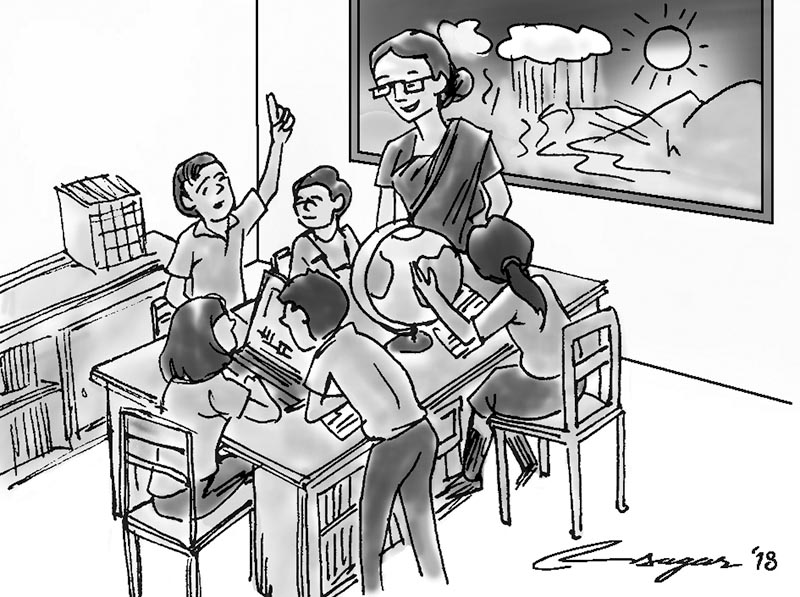Didactics and pedagogy: Enhancing students’ performance
The global living conditions are changing, showing an upward trend. We need to understand learning in the context of globalisation, and global challenges mean preparing students to cope with the prevailing situations
Didactic competence is about the knowledge of how to teach and communicate knowledge to students. It refers to being able to decide appropriate methods of teaching so that different pedagogical goals can be realised. It includes utilising everyday life and children’s experiences to tackle with the problems.
It has been derived as a general understanding of education that there are three dimensions of education—increase in cognitive competition, increase in capacity to act and increase in ability to reflect.
Didactics has been developed as an essential part of general pedagogy and teacher education and didactic competencies include an overview of different didactical methods and instructional design approaches as well as an understanding of different scenarios for teaching and learning activities. It helps to expand the horizon of knowledge, use of new technologies and new forms of communications.
The pedagogical competencies include development of teaching and learning resources, teaching techniques, e-learning, students’ assessment, students’ motivation and classroom management.
Teachers (school or university), therefore, need to be sensitised on the need of enhanced didactic competencies.
Pedagogical competence is based on sound, broad and current knowledge within the subject area, as well as knowledge of student learning and subject-based teaching and learning issues. It also presupposes a reflective and critical approach to teaching, learning and pedagogical development over time.
The global living conditions are changing, showing an upward trend. We need to understand learning in the context of globalisation, and global challenges mean preparing students to cope with the prevailing situations.
Therefore, teachers need to develop didactic competencies in the field of teaching-learning activities that help to create knowledge in an open-minded manner with new perspective. The quality of teacher is reflected in student’s performance.
Therefore, teacher should be mentally prepared for developing didactic and pedagogical competencies in order to make students competent in the competitive world.
Another competency area is that of the subject matter, which is associated with content-related expertise. Besides, teachers should adopt pedagogical approaches to the specific subject matter as the subject-based pedagogical knowledge is vital to the teaching profession. Generally the concept of competence is defined as an integrative set of knowledge, abilities, attitudes and capacity to apply and transfer them that create the premises of successful accomplishment of certain complex activities or tasks and of effective functioning within a given context.
In this regard, it is worth mentioning that the understanding didactic triangle is necessary to develop didactic competencies amongst the teachers. The didactic triangle is composed of three axes—teacher-student, teacher-subject and subject-student.
The strength of using the didactic triangle lies in the fact that the triangle defines different types of relationships between teacher, student and subject matter, and the possibility of linking these relationships to a structural context.
The teaching aspect and teacher-student axis concerns knowledge of classroom interactions and group processes as well as the ability to handle them. The axis concerns the teacher’s insight into what goes on in the didactic room and about the teacher, including the teacher’s leadership and teaching style.
Therefore, this axis represents the micro aspects of teaching along with the link between the teacher’s values and intentions, and the teacher’s ability to achieve a constructive learning environment. The rhetoric aspect and teacher-subject axis refers to how the teacher recognises his or her own actions in relation to the subject, or what should be communicated, how and why.
Communication in this sense is about rhetoric, including the teacher’s experience, oratory, understanding of the receiver and ability to achieve a given communicative goal. This axis is about having an area of knowledge (the subject) and an ability to illustrate it. The axis also assumes, in a didactic sense, that a teacher is self-aware about his or her use of tone of voice, body language, eye contact and the whiteboard.
The third is the subject-student axis, which deals with an understanding and an exposition of the subject matter so that the student can learn in the best way.
This axis tells about how subject content can be made accessible to the student so that it is both individualised and has a progression. An important factor in this axis is the pre-understanding that the teacher assumes the student has, thus allowing the student to understand the subject and enabling the teacher to believe that he/she can lead the individual and group.
A teacher who combines a conscious didactic approach with a flexible approach to students in a teaching situation should be better able to embrace didactic leadership than a teacher who has difficulties with embracing alternative cognitive, physical, and verbal approaches to students.
Joshi is a faculty member at Patan Multiple Campus






